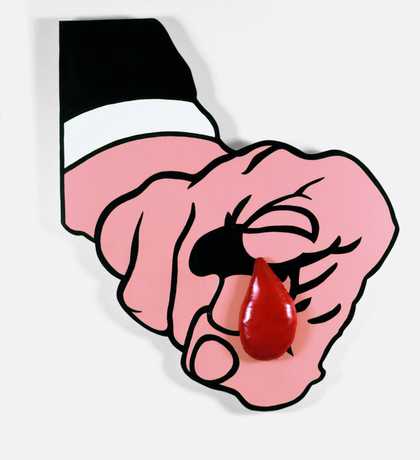Was ‘pop art’ a term used by yourself or colleagues or was there a different terminology that referred to a new figurative art movement in the 1960s and early 1970s?
The terms used among us were ‘new figuration’ movement also called ‘new objectivity’.
Did you ever consider yourself (now or in the past) a pop artist?
Yes, in the past I considered myself a ‘new objectivity’ artist.

Marcello Nitsche
I Want You 1966
Museu de Arte Moderna, São Paulo, Brasil
© Marcello Nitsche
Did your work engage with current events in the 1960s and early 1970s?
Yes, I participated in events such as: the IX and X São Paulo Biennials in 1967 and 1969 respectively; the exhibition of the labour trade union of São Paulo; the group exhibition entitled New Objectivity, at the Modern Art Museum of Rio de Janeiro in 1967; and the National Expo of Brasilia in 1967, where my work was destroyed by the military.
How did you choose the subject matter for your work included in The World Goes Pop?
In the work entitled I Want You the visual language was based on the American propaganda poster of the time bearing the words ‘I want you for the US army’. The work entitled Kill Fly was a reference to dictatorship; it was the camouflaged way I found to speak out against the military regime.
Where did you get your imagery from (what, if any, sources did you use)?
In general I sought to use visual elements of everyday life, practising a language that the Brazilian people already knew. Based on this language, I inserted a criticism about the system.
Were you aware of pop art in other parts of the world?
In fact, beyond the North American imagination, I was touched by the popular culture of Brazil.
Was commercial art an influence on your work or the way in which it was made?
Both.
Was there a feeling at the time that you doing something important and new, making a change…?
Yes, it was totally conscious.
Was there an audience for the work at the time – and if so what was their reaction to it?
Yes, there was a large group of intellectuals who understood the purpose of the works. In a time of conflict, some saw them as protest works, such as in the incident at the National Expo of Brasilia, when all my work was destroyed by the military.
Looking back at these works, what you do think about them now?
I realise that these works display the concerns of their time, but even though today they belong to the past, a historical political moment, many people still are surprised by them.
I decided to complement our interview with a conversation that I had with the artist Robert Rauschenberg, when he was in São Paulo for the Biennial in 1967. I had the opportunity to exchange ideas with him about the works exhibited, and he told me that one of the interesting features of his observations was that the works of art were not finished as well as those of the Americans, and that they were more consistent with our reality!
September 2015
